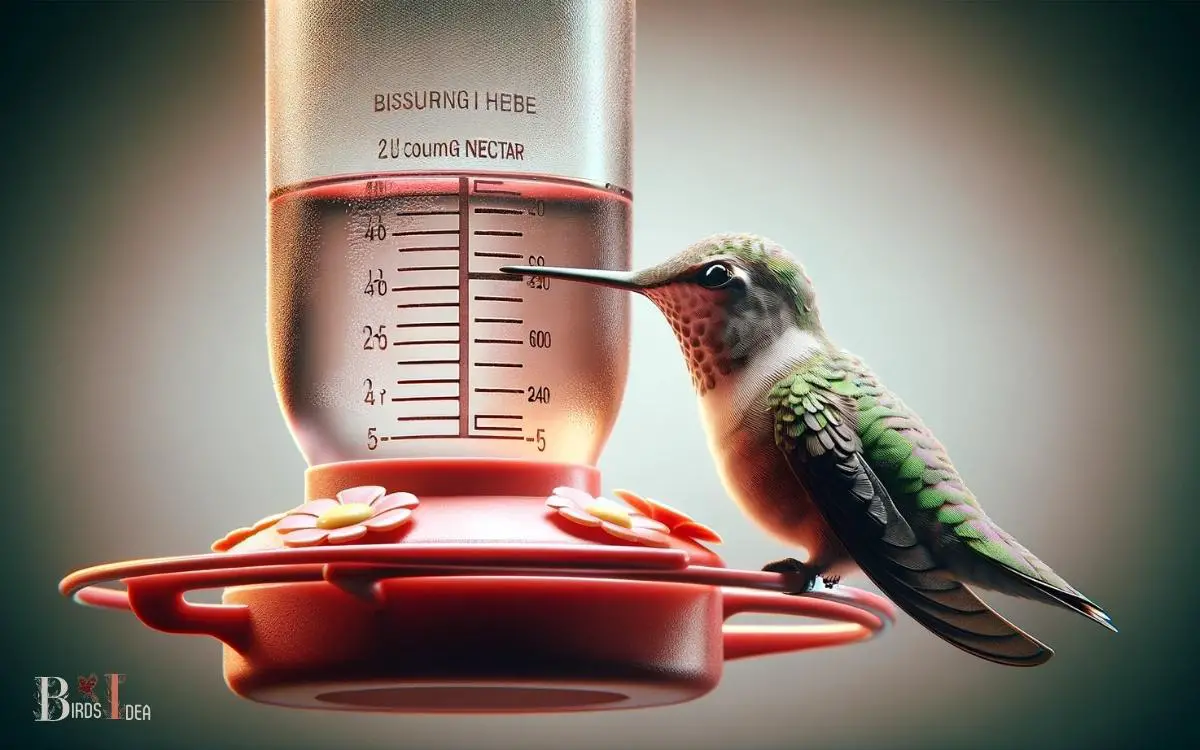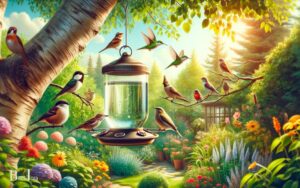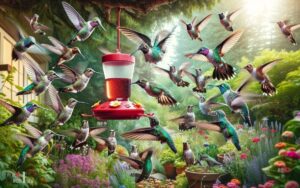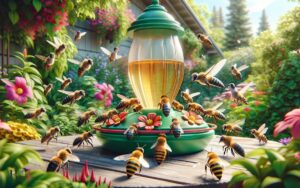How Much Does a Hummingbird Drink? Discover!
Hummingbirds typically drink up to half their body weight in sugar water or nectar each day. They may visit a feeder between 5 to 8 times per hour, with each visit lasting around 30 seconds.
The amount of nectar a hummingbird drinks can depend on several factors:
For example, a Ruby-throated Hummingbird weighing around 3 grams might consume up to 1.5 grams of nectar daily.
Attracting these nectar-loving birds requires understanding their dietary needs and creating a hospitable feeding environment.

Key Takeaway
Hummingbird Nectar Consumption
Hummingbirds consume nectar for both energy and hydration, relying on the sugar content of the nectar to fuel their high metabolism and the water content to meet their hydration needs.
Due to their rapid wingbeats, which can range from 720 to 5400 beats per minute, hummingbirds have a substantial need for energy.
The sugar in the nectar provides them with the necessary calories to support their high activity levels.
The nectar serves as a source of hydration for these tiny birds. Hummingbirds have high water requirements, and the nectar they consume helps fulfill this need.
Their ability to efficiently extract nectar using their specialized tongue allows them to meet their energy and hydration requirements, enabling them to thrive and serve essential roles in their ecosystems.
Factors Affecting Hummingbird Drinking
The amount a hummingbird drinks is influenced by several key factors. These include the bird’s diet and hydration, as well as the environmental conditions in which it is living and drinking.
Understanding these factors can provide valuable insights into the drinking habits of hummingbirds.
Diet and Hydration
A significant factor affecting the drinking habits of hummingbirds is the availability of nectar-rich flowers in their environment.
Hummingbirds primarily feed on nectar from flowers, which provides them with the necessary energy and hydration.
The following table outlines the preferred nectar sources for some common species of hummingbirds:
| Hummingbird Species | Preferred Nectar Sources |
|---|---|
| Ruby-throated | Trumpet creeper, bee balm, honeysuckle |
| Anna’s | Salvia, penstemon, fuchsia |
| Rufous | Indian paintbrush, currant, gooseberry |
| Black-chinned | Ocotillo, chuparosa, lantana |
Understanding the specific nectar preferences of different hummingbird species is crucial for creating environments that can support their hydration needs.
This dietary information highlights the close relationship between hummingbirds and the availability of nectar-producing plants in their environment.
Transitioning into the subsequent section about ‘environmental conditions and drinking’, it is important to consider how the habitat influences the hydration habits of these remarkable birds.
Environmental Conditions and Drinking
Transitioning from the dietary habits of hummingbirds, the availability of nectar-rich flowers significantly influences their hydration needs, often prompting frequent visits to floral food sources.
Environmental factors such as temperature, humidity, and altitude also play a crucial role in the drinking behavior of hummingbirds.
In warmer climates, where water availability may be limited, hummingbirds rely more heavily on nectar with higher moisture content to meet their hydration needs.
High altitudes can pose challenges as the lower air pressure results in faster evaporation of water from the hummingbird’s body, requiring them to drink more frequently.
Moreover, in drier conditions, such as arid regions, hummingbirds may need to increase their fluid intake to compensate for the lack of water sources.
Understanding these environmental influences is essential in providing appropriate support for hummingbirds in various habitats.
Daily Water Intake of Hummingbirds
Hummingbirds’ daily water intake is a crucial aspect of their survival. Understanding the factors influencing their water consumption, such as environmental conditions and diet, is essential for their care and conservation.
By examining the daily water intake of hummingbirds, we can gain valuable insights into their physiological needs and behavior.
Hummingbirds’ Water Consumption
The daily water intake of hummingbirds is a crucial factor in understanding their hydration needs and overall health.
Hummingbirds have high metabolic rates, and water is essential for regulating their body temperature and supporting their rapid energy expenditure.
The table below provides an overview of the daily water intake of hummingbirds based on their body weight.
| Body Weight (g) | Daily Water Intake (ml) |
|---|---|
| 2 | 4 |
| 4 | 8 |
| 6 | 12 |
As shown in the table, hummingbirds’ daily water intake is approximately 2 times their body weight in milliliters.
Understanding their water consumption is crucial for maintaining hummingbirds’ health, especially during migration and in hot climates. Providing accessible sources of clean water is vital to support these remarkable birds.
Feeding Frequency of Hummingbirds
Throughout the day, hummingbirds maintain a consistent feeding frequency to sustain their high metabolism and energy requirements.
Their feeding patterns are as follows:
- Every 10-15 Minutes: Hummingbirds are known to feed every 10-15 minutes during the day, visiting an average of 1,000 flowers to meet their nectar needs.
- Dusk Feeding: They engage in a final feeding session at dusk to store up energy for the night, as they enter a state of torpor to conserve energy during the night.
- Body Weight Maintenance: This regular feeding schedule is crucial for hummingbirds to maintain their body weight and support their intense energy demands.
The consistent feeding frequency of hummingbirds is essential for their survival and ability to sustain their high metabolic rate.
This regular intake of nectar allows them to meet their energy requirements and maintain their health and vitality.
Moving forward, it’s important to understand the significance of hydration for hummingbirds.
Importance of Hydration for Hummingbirds
To ensure the well-being and survival of hummingbirds, it is imperative to recognize the critical role of hydration in supporting their high metabolic rate and energy demands.
Hummingbirds rely on nectar for a substantial portion of their diet, which provides the necessary fluids to maintain their hydration levels.
Hydration is essential for their overall health, as it aids in digestion, nutrient absorption, and temperature regulation.
Insufficient hydration can lead to decreased energy levels and compromised immune function, impacting their ability to forage and migrate effectively.
The table below provides an overview of the daily water intake and nectar consumption of hummingbirds, highlighting the significance of hydration in their daily lives.
| Hummingbird Species | Daily Water Intake (ml) | Daily Nectar Consumption (ml) |
|---|---|---|
| Ruby-throated | 4-6 | 5-7 |
| Anna’s | 6-8 | 8-10 |
| Rufous | 7-9 | 9-12 |
How Much Hummingbird Food Should I Provide to Accommodate Their Drinking Habits?
Hummingbirds have small stomachs and high metabolisms, so it is crucial to provide them with sufficient food to accommodate their drinking habits. While it is important to offer a consistent supply of nectar during the day, there is no need to worry about feeding them at night. Fortunately, the nighttime hummingbird food mystery solved – these delightful creatures naturally decrease their activity level and rest during nighttime, conserving energy for their active daytime routines.
Unique Drinking Behavior of Hummingbirds
Hummingbirds’ unique drinking behavior, characterized by rapid and precise tongue movements, plays a crucial role in their efficient nectar consumption and overall hydration.
This behavior enables them to swiftly extract nectar from flowers, ensuring their rapid energy replenishment and hydration.
The remarkable drinking behavior of hummingbirds involves:
- Extending their long, slender tongues deep into flowers to reach the nectar.
- Lapping up nectar at a rate of up to 13 times per second, utilizing their specialized tongues to maximize fluid intake.
- Utilizing their tongues as tiny pumps, quickly drawing nectar into their mouths during each feeding bout.
Such specialized drinking behavior allows hummingbirds to efficiently obtain the sustenance needed for their high-energy lifestyles, making them marvels of adaptability and resourcefulness.
Conclusion
The drinking behavior of hummingbirds is a fascinating and essential aspect of their survival. Understanding the factors that affect their nectar consumption and daily water intake is crucial for creating a suitable environment for them.
By attracting hummingbirds to your garden and providing the necessary hydration, you can support their well-being and contribute to the conservation of these remarkable creatures.
How can we ensure that we are doing our part to protect and support the hydration needs of hummingbirds?






